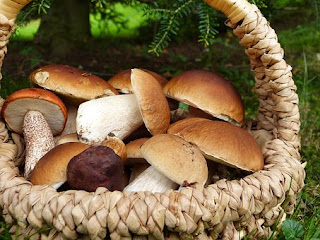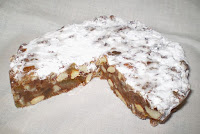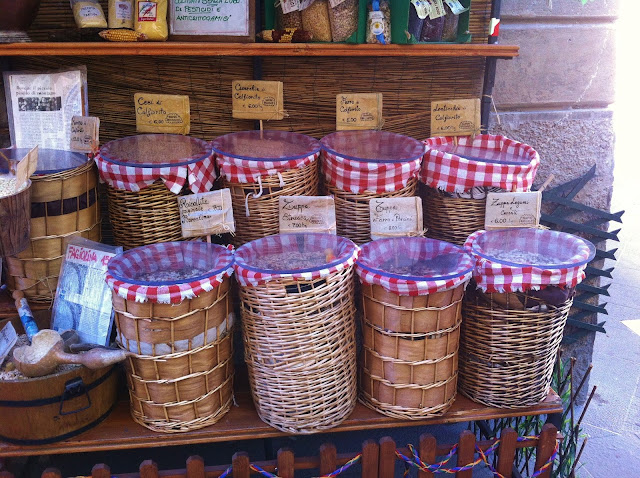We all have images of Tuscany: charming hill towns, cypress-lined lanes leading to gorgeous villas, museums packed with magnificent art, exquisite red wines and food...oh, the food!

Like all Italian cuisine, Tuscan food is delicious, hearty and made with the freshest ingredients imaginable. Yet, compared to other regions of Italy like Emilia-Romana and Veneto, Tuscan food is rather simple as well. Southern Tuscany is an area of cattle ranches and cowboys, producing Italy's famous Chianina steak! Of course, any region that eats lots of steaks will also have red wine, and Tuscany produces some of Italy's most superb full-bodied red wines.
Every state in Tuscany has its slightly different version of a classic Tuscan dish that has remained unchanged for centuries. Whether it is a pasta shape or the addition of mushrooms to a specific soup, the subtle differences in the recipes make it fun to try the same dish in different areas of Tuscany.
OK, a quick word on Tuscan bread. It looks great, but it tastes, well...bland. Here's the "Urban Myth" about why: In the Middle Ages, the Pope declared a tax on salt and Tuscans refused to use salt in their cooking even in their bread. To this day, the Tuscan proudly serve their bread crusty on the outside, soft in the middle and happily unsalted. At least that's the STORY, I just think Tuscans prefer their bread unsalted.
Antipasto
 |
| Fettunta goodness |
Crostini - this is also a type of bruschetta, but the toasts are topped with a delicious chicken liver and caper pate. Most restaurants offer a "crostini misto" where there are three slices of toasted Tuscan bread, one with olive oil (that our son ate), one topped with chopped tomato and basil (that one my husband ate) and one with chicken liver pate that was left for me. Let's say I ended up acquiring a taste for it. 😖
 |
| Wheels of Pecorino in Pienza |
Pecorino cheese - The regional cheese of Tuscany is delicious Pecorino; "Pecora" in Italian means sheep. Often called "cacio" in Tuscany, sheep milk cheese is a very creamy hard cheese and more accessible than cow's milk cheese. Try the Pecorino Fresco, which is the younger and softer version of the cheese, it also has a milder flavour than aged Pecorino. The best Pecorino cheese in Tuscany comes from the area of Pienza in the province of Siena.
Primi
Panzanella - Without salt, that
gorgeous bread gets stale very quickly. So what do you do with all your
day-old bread? Turn them into salads in the summer and soups in the
winter! Panzanella salad is made by soaking stale bread in water and then
squeezing the liquid out. Amazingly, the bread does not get soggy in the
water! Next, add chopped fresh tomatoes, onions, basil and a delicious oil &
vinegar dressing and you have a gorgeous summer salad!
Ribollita - This favourite soup is served throughout Tuscany and uses leftover bread, beans, vegetables and cabbage or kale. Ribollita means "reboiled," and it is really boiled twice to give this soup depth of flavour. Ribollita is said to have gotten its name from when the servants used to get the leftover food and bread from their wealthy Lord's banquet tables and reboiled it into a soup for a meal. Tuscany has many other delicious and hearty soups to try like Acquacotta, which also uses leftover bread and Pappa col Pomodoro, which is a fresh tomato puree.

Pici- In southern Tuscany, the pasta that is on every
menu is in the shape of thick, chewy curls. Looking like super thick
spaghetti, pici pasta is made from flour and water (omitting the egg) and is
hand-rolled, making it uneven in length and width. This pasta is super fun
to eat and is often served with a ragù or meat sauce.
Secondi
 |
| Bistecca alla Fiorentina |
 |
| Typical Shop Front of Tuscany |
Cinghiale - Wild Boars are known as the "Kings of the Forest" and are plentiful in Tuscany and Umbria. The boars are not welcomed in Tuscany because they wreak havoc in vineyards, uprooting the grapevines and trampling young plants. Hunting season begins in Autumn, and you find cinghiale on every restaurant menu in stews, sauces called ragù, sausage and many different types of delicious salumi. I just loved any kind of cinghiale salumi.
 |
| Chianina Cattle |
Lampredotto -This is a typical Florentine street food. There are little food trucks or carts that serve Lampredotto, which is a braised cow tripe served in a bun. I didn't know that these carts only open up to sell Lampredotto in the Autumn, and as we were visiting Florence at the end of September, they were super busy! I know many of you may think, "Ewwww, organ meat!" But trust me, late at night strolling around Florence with a lampredotto and a glass of Chianti doesn't get any better!
Contorno
 Vegetables in Tuscany are fresh, delicious and plentiful. The Tuscans eat with the seasons, so what you get in the shops and restaurants will depend on what time of year it is. Spinach is abundant in Florence, and it can be found in everything; soups salads and even kinds of pasta. Cannellini beans are ever-present in Tuscan cuisine, and the Tuscans are sometimes teased as mangiafagiolis or "bean eaters." I was there in the fall, so it was the beginning of the mushroom and truffle season, which was an exciting time.
Vegetables in Tuscany are fresh, delicious and plentiful. The Tuscans eat with the seasons, so what you get in the shops and restaurants will depend on what time of year it is. Spinach is abundant in Florence, and it can be found in everything; soups salads and even kinds of pasta. Cannellini beans are ever-present in Tuscan cuisine, and the Tuscans are sometimes teased as mangiafagiolis or "bean eaters." I was there in the fall, so it was the beginning of the mushroom and truffle season, which was an exciting time.Porcini Mushrooms- These huge mushrooms herald the beginning of the Autumn Season in Tuscany. Often these mushrooms are foraged daily from the local hills and displayed in a basket outside the restaurant door luring in hungry customers. A delicious sauce to try on your pici pasta is boscaiola made from funghi porcini or porcini mushrooms.
Dolce

BONUS:
Ok, I know I have given you 10 things to try, but we MUST have dessert! Tuscans are not known for their elaborate desserts because their cooking heritage developed from rustic cowboy cooking, except for Sienna. One would think with the opulence of Florence during the Renaissance, that decadent desserts would be abundant, but that is really not the case. Although today some of the best gelatos can be found in Florence, Siena still "takes the cake" in the traditional dessert category.
 |
| Homemade Panforte |

Ricciarelli- These little sugar and almond cookies should come with a warning label! They are so entirely delicious and addictive that you can not just have one! Technically ricciarelli are macaroons drenched in powdered sugar. These cookies are another Sienese dessert brought back from the crusades in the late Middle Ages- and probably one of my favourite Italian words to say! The legend has it that a nobleman brought the recipe back from the Middle East and started to make almond cookies shaped like little Turkish slippers in his castle in Volterra near Siena. These delicate, chewy almond cookies are great dipped in Vin Santo or other sweet Italian dessert wine and can also come in a non-traditional chocolate variety.

Whatever you eat in Tuscany, my biggest tip I can give you is to skip any restaurant with a tourist menu. Ask a local shop owner for a restaurant recommendation, or even more telling, where they go out to eat. Look for a small restaurant with a limited menu that is only written in Italian. If the menu is handwritten, that's an even better indication of an authentic eatery! Be adventurous, what may sound strange or scary to you will probably really surprise you! Ask your waiter to recommend a dish; say, "I am in the mood for chicken; what do you recommend?" The waiters have a vast amount of pride in what they serve and knowledge of the seasonal food. I often ask my waiter to also recommend a local wine pairing for my meal as well...they are experts, after all.
Have you got a favourite Tuscan dish that folks MUST try that I did not cover? Let me know in the comments below.
Follow me on FACEBOOK, INSTAGRAM and BLOGLOVIN' for daily photos and updates! #slowtravel🐌



No comments:
Post a Comment